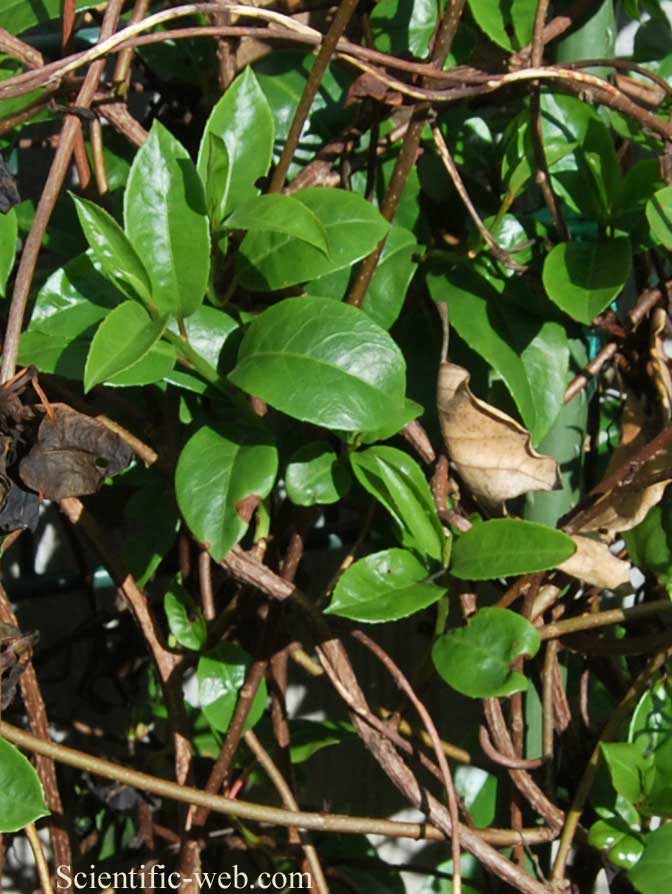
Kadsura japonica, Photo: Michael Lahanas
Classification System: APG IV
Superregnum: Eukaryota
Regnum: Plantae
Cladus: Angiosperms
Ordo: Austrobaileyales
Familia: Schisandraceae
Genus: Kadsura
Species: Kadsura japonica
Name
Kadsura japonica (L.) Dunal
Synonyms
Uvaria japonica L.
References
Monographie de la Famille des Anonacées. Paris, London, Strasbourg, Montpellier 57. 1817 (A. L. de Jussieu, Ann. Mus. Hist. Nat. 16:340. 1810, nom. inval.)
USDA, ARS, Germplasm Resources Information Network. Kadsura japonica in the Germplasm Resources Information Network (GRIN), U.S. Department of Agriculture Agricultural Research Service. Accessed: 08-Apr-12.
Vernacular names
日本語: サネカズラ, ビナンカズラ
Kadsura japonica, commonly known as the kadsura vine or simply kadsura, is a plant species native to Japan (Honshū, Kyūshū and the Ryukyu Islands) in woodlands. The larvae of the moth Caloptilia kadsurae feed on K. japonica in the main Japanese islands and Ryukyu Islands.
Description
Kadsura japonica is a cultivated, dioecious, ornamental plant in gardens, with edible fruits that can be eaten raw or cooked.[1] It grows from 8 feet (2.4 m) to 15 feet (4.6 m). It is an evergreen with deep green, glossy leaves that turn slightly red in autumn. Its fruits are very bright scarlet[2] and it has white, unisexual flowers.[3][4] This plant contains 1–3 seeds. The apex is acuminate. The leaves are variegated, shiny green and irregularly edged in white. The flowers are cup shaped and have red berries in spring. The petioles are 0.6–2.3 cm long. 5–8 secondary veins can be found on each midvein in the leaves. In common with other plants in the family Schisandraceae, this species can be monoecious although it is often reported as dioecious, and may change sex expressions over time.[5][6][7]
Taxonomy
Kadsura japonica was one of the many species first described by Linnaeus in the 10th edition of his Systema Naturae in 1759, originally as Uvaria japonica.[8]
Kadsura is one of the three genera of the family Schisandraceae. It contains 22 species.[9]
Distribution and habitat
It is found in the tropical and subtropical habitats and can be grown as an indoor plant. This plant is found in Japan, southern China, southern Korea and eastern Asia. It can be in habitats such as woodland garden, found in both the sun and shade. It grows in a moderate and fertile soil. It needs a neutral or acidic soil, that is adaptable and well-drained. This plant mostly does not need bright sunlight. In autumn, the shoot of the plant becomes very long and forms layers. It is a climber on woodland trees. It is found at an elevation of 500–2000 m in some provinces of China, Fujian and Taiwan.[10]
Uses
Fruit from this plant is edible and is eaten either raw or cooked. Material extracted from this plant is used for hair dressing. Extracts from this plant are also used for traditional Japanese washi paper making.[11]
References
Pink, A. (2004). Gardening for the Million. Project Gutenberg Literary Archive Foundation.
"Illiciales". Encyclopædia Britannica. Retrieved 9 February 2014.
"Kadsura japonica". NC State University. Retrieved 9 February 2014.
pfaf.org: Kadsura matsudai (Kadsura japonica)
"Kadsura japonica". Useful Tropical Plants. Useful Tropical Plants Database. August 16, 2016. Retrieved October 15, 2016.
"Kadsura japonica 'Variegata'". Plant lust. Plant lust. Retrieved October 15, 2016.
Saunders, Richard M.K. (June 22, 1998). "Monograph of Kadsura (Schisandraceae)". Systematic Botany Monographs. 54: 23. doi:10.2307/25096646. JSTOR 25096646.
Linnaeus, Carl (1758). Systema Naturae per Regna Tria Naturae, Secundum Classes, Ordines, Genera, Species, cum Characteribus, Differentiis, Synonymis, Locis (in Latin). Vol. 2 (10th revised ed.). Holmiae: (Laurentii Salvii). p. 1082.
"Illiciales". Encyclopӕdia Britannica. Encyclopӕdia Britannica, Inc. June 30, 2008. Retrieved October 15, 2016.
"Kadsura japonica". Useful Tropical Plants. Useful Tropical Plants Database. August 16, 2016. Retrieved October 15, 2016.
"Kadsura japonica". Useful Tropical Plants. Useful Tropical Plants Database. August 16, 2016. Retrieved October 15, 2016.
Retrieved from "http://en.wikipedia.org/"
All text is available under the terms of the GNU Free Documentation License

